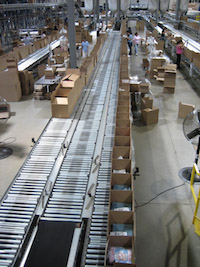 When I first started going down the path of product manufacturing, I had no idea what to expect.
When I first started going down the path of product manufacturing, I had no idea what to expect.
Finding suppliers, vetting them, and getting things made seemed like daunting tasks at first.
What if I get scammed? What if there’s a mistake in the final run? Do I even know what I’m doing? What if this goes nowhere?
But as time went on, I realized it was actually quite simple because the manufacturing process is relatively straightforward.
You find a supplier, see if they are legit, send them a design, get some samples made, tweak them, negotiate a bit, put it in a final order, design some packaging, and find a warehouse to ship/store the products.
What isn’t straightforward is the path that gets you there – obstacles such as revisions on the design, finding the right raw materials, dealing with fake certifications, national holidays, natural disasters, poor communications, and various other factors that can extend the process for weeks, if not months.
As indie writer Merlin Mann said, “Everything takes more time than you thought, everything costs more money than you thought, and almost everything turns out not quite as cool as you thought.”
Ain’t that the truth?
Here are five things you should know before getting into making physical products:
1. Table Selection Is Key
 The concept of table selection in business comes from the founder of Zappos Tony Hsieh. Before he got into e-commerce, he was an avid poker player and realized that the majority of success or failures he encountered were largely predetermined by the tables he sat in.
The concept of table selection in business comes from the founder of Zappos Tony Hsieh. Before he got into e-commerce, he was an avid poker player and realized that the majority of success or failures he encountered were largely predetermined by the tables he sat in.
For example, playing with drunk tourists is a much easier win than a table of pros in a no-limit game. It’s not as glamorous as being on the World Poker Tour, but the chances of consistently taking money home are much higher.
Table selection also applies to business models and your niche. Making the next iPhone is infinitely more difficult, challenging, and expensive than scented candles, dog food, tissue paper, or a leather wallet. Making an iPhone involves thousands of suppliers, high tech engineering, a global marketing machine, thousands of staff, and much more.
If you’re getting into manufacturing, make sure to think through the entire supply chain and some high level strategery.
 Can I clearly map out the production process?
Can I clearly map out the production process?
How many total suppliers are involved?
What are the choke points?
How much storage will I need?
What are the margins?
How will I ship them?
What’s my advantage?
How defensible is my business model?
The irony is that many entrepreneurs often look back and wish they were in another niche. One person I’ve spoken to hates fabricating steel in China. Another has perishable products in hot weather. Another chose a market that simply wasn’t big enough.
There’s no such thing as a perfect niche, and it’s okay to switch tables if you discover it’s too hard to win. (Although this is 1,000 times easier said than done.)
Moral of the story: find a table where you can consistently win and still enjoy playing at 3-5 years down the line.
2. You’ll Develop Product Obsession
 Once you decide on a niche and jump down the rabbit hole, it’s a whole new world to learn. There’s new terminology, lingo, and industry-speak that everyone uses in the supply chain.
Once you decide on a niche and jump down the rabbit hole, it’s a whole new world to learn. There’s new terminology, lingo, and industry-speak that everyone uses in the supply chain.
For example – the Italian leather I use takes roughly 40 days to produce as the process of vegetable tanning is a very long one, descended from ancient Egypt as early as 1500 BC. Each tannery has their own “special sauce” passed from generation to generation which makes them unique. Since leather comes from an actual cowhide, no piece is ever identical to another.
Luckily, this is where Google comes in handy to help you understand anything from making tissue to quantum physics. As you go down this path, you’ll also learn who the suppliers are – good ones, bad ones, key players, movers and shakers, and how the landscape is transforming 3-5 years down the road.
 Spend time learning about the raw materials that go into your product, and how the manufacturing process is done from start to finish.
Spend time learning about the raw materials that go into your product, and how the manufacturing process is done from start to finish.
This will not only give you the baseline knowledge needed to make improvements down the line, but also confidence in talking to customers about the quality behind your brand.
It’s also great content for the website as customers enjoy seeing what happens behind the scenes.
Finally, take note of the landmark industry conferences where suppliers, vendors, and merchants gather. High-friction events like these allow you to deepen your network and knowledge within the industry.
As an outsider going in, you’ll have a fresh perspective while more established competitors may be less agile and internet savvy.
3. The First Sample Usually Sucks
 Manufacturing is never done right the first time – it’s a long process of putting something onto paper, creating a sample, tweaking it, and improving it along the way.
Manufacturing is never done right the first time – it’s a long process of putting something onto paper, creating a sample, tweaking it, and improving it along the way.
Depending on the complexity of your products, this could take months or up to a year if it has a lot of moving parts involved.
Because of this, you’ll need a high level of patience and tolerance to see things through. If you’re in America and the supplier is in a different timezone in Asia, expect this to be even more difficult.
When you’re just using the phone and email for communications, presenting the right context and intent is very challenging if there’s a language barrier involved. This is why sourcing experts like Matt and Jamin from High Cappin always recommend visiting your supplier if possible.
 It’s also much easier to figure some things out in person. For example, if you want a zipper changed from black to blue, what shade of blue do you mean?
It’s also much easier to figure some things out in person. For example, if you want a zipper changed from black to blue, what shade of blue do you mean?
Is it the light blue on Apple’s website or the blue of a Levi’s jeans? It only gets more complicated when you involve multiple suppliers.
Which brings me to the next point…
4. Things Take Forever
 Every manufacturing process has a lead time.
Every manufacturing process has a lead time.
This can range anywhere from a few days to a month depending on your product complexity, volume of orders, and other factors that are sometimes out of your control. In some cases, your lead time may depend on your supplier’s supplier providing the raw materials and parts.
Once the product is made, you’ll also need to ship them to your apartment, warehouse, or fulfillment center. Along the way it may have to go through customs, inspections (if you’re unlucky), and transportation across land from the port of entry.

And don’t forget about national holidays or disasters such as earthquakes, hurricanes, Kaiju attacks, or fires that may wreck havoc on logistics.
All of a sudden something that just took a month gets dragged on to two months or longer because the entire timetable gets pushed back.
If it’s your first time, you’ll also need to get photography handled.
5. Money Will Be Tied Up
 If you’re just starting out, manufacturers in Asia will typically require money to be paid 100% upfront.
If you’re just starting out, manufacturers in Asia will typically require money to be paid 100% upfront.
Unless you’ve already visited the supplier or was recommended through a contact (guanxi), you’ll have little room to negotiate if you’re only putting in minimum orders.
Nevertheless it’s worth trying, but promising a big order and not executing on it just makes you look stupid because they get this from plenty of amateurs. In the end, if you’re not comfortable with minimum orders, some manufacturers are okay with lower quantities at the expense of higher unit prices.
It also never hurts to get quotes for different quantities just to see how the cost scales. A great example is product packaging, where a minimum of 1,000 boxes might have cost you $200, but increasing it to 5,000 only costs you $500. In that case, you might as well double down and get 5,000 if you’re moving plenty of product every month.
As the business relationship grows they’ll accept better payment terms, such as 50% deposit and full payment upon shipment of products (or better). Knowing how big of a customer you are to them is also critical, as it determines how much leverage you have on their business for better customer service, pricing, and quality.

But as with any B2B relationship, there is a fine line to walk so both sides are happy to continue doing business with each other.
On the other side if you’re dealing with wholesalers, many will have payment terms of net 30-days (or worse) after they receive the inventory, so your cash conversion cycles gets dragged out.
Kickstarter is a great way to short-circuit this as you collect money upfront without inventory risk, but that’s for another post.
Wrapping Up
If you’re going down the path of product manufacturing in the future, make sure you’re ready to invest a lot of time, money, and energy into the process. The risks are much higher than other business models, but so are the rewards.
There’s a great feeling of accomplishment when you take an idea, turn it into a physical product, and have someone buy it for the very first time.
It’s like seeing the Matrix because you realize it’s possible to create, change, and make new things in this world.
Subscribe to Build My Online Store in your favorite podcast player, or check out the episode list of our eCommerce podcast.
Want More China Manufacturing Insights?
Check out this epic 3 part blog post on how I prototyped and built my product in China.


Comments
I think you’ve hit just about everything with this one, Terry. Number 4 in particular is a killer. From idea to having the physical product in hand to sell is easily 2, 3, 4 months and that’s without needing to design much.
That might not sound like a lot of time in the grand scheme of things, but when you’re all hyped up about this new product you have and you just can’t wait to offer it for sale, it feels like an eternity.
These really are great tips for what a newbie can expect getting into this game.
Rock on – just lots of time, money, and energy involved!
You always deliver the goods Terry. Awesome post!
Your welcome sir!
Wow, I wish I had read this six months ago! Most of those points hit home and I’m sure as I get further into the process the rest will resonate as well.
I have a newbie question. A friend and I developed a prototype for a custom backpack application and we’re currently working with a manufacturer in the sample phase. My question might be more in regards to lingo than the actual process. I keep using the term “manufacturer” to describe who I’m working with where in this post, and on TMBA, it always seems like you guys say “supplier” and I’m trying to understand the difference, if there is one. The company I’m working with offers several services which includes wholesaling backpacks as well as creating custom solutions. Since the company that’s making the sample also has their own supplies would it be correct to say that my manufacturer is also my supplier?
My concern is that I’m missing some critical step because in my mind I’ve never dealt with a “supplier”. But I also think it might be okay in my situation because of the type of product I’m making. Take Dan & Ian as an example, I understand that for their portable bars they might have several suppliers for the different components of their bars (wheels, steel, plastic, etc.) where they have all these items delivered to their manufacturer to assemble into a finished product. Is that a correct way to state this?
Basically, I’ve never sourced my own material. I created a prototype and sent it to a manufacturer to create a sample and give me first run cost. I’m starting to think the problem with this is that it will make the product more expensive than it should be. Like having a mechanic replace parts on a vehicle, I’m already paying a lot in labor and now I’m paying a 2-3x markup on the material as well. Perhaps the better option would be to find a contract sewing company and source the material myself? If I went this route I’d say I have both a supplier and manufacturer.
Well hopefully since I wrote so much I at least articulated my concern clearly. Thanks for any insight you can offer! And thanks for the great article!
Depends on how many component parts your bags has – I don’t make bags but from conversations with other folks in the industry, your bag manufacturer will often have their own suppliers for zippers, fabric, etc. with some established relationships. in some cases, working with an agent might be more beneficial as they have numerous contacts within the supply chain.
That being said, you could also source your own modificatons of different things and send them to your supplier. It will likely take longer to prototype/produce but it’s up to you on the features you want.
FYI manufacturers are typically create your final product, and they administrate if they have suppliers that source them certain bits for their assembly. Suppliers is a more general term for ‘anyone that contributes to the creation of the product’ and can refer to manufacturers you have a working relationship with (as in you can be hands on with their tooling and supply chain) or manufacturers that make bits they then hand over to the manufacturer of your product for assembly. Strictly speaking the guys that make the buttons for my shirt are suppliers, the guys that make the cotton are suppliers. The guys who sew buttons on shirts are assemblers or manufacturers depending on if they supply any base materials (apart from labor) too.
I want to begin making a toy line. I’m working on prototypes. I am creative and love working with my hands and have no clue how to look into getting these things manufactured. Where do I start. Are there special companies that specialize in toys? I’m not sure how to make the next step.